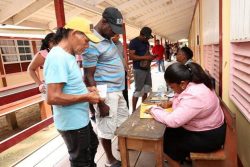Grassfire yesterday razed across a field on the University of Guyana Turkeyen campus and though no one was hurt, it raised questions on precautions taken by the university to avoid such occurrences.
The fire started on the north-eastern side of UG’s campus, on a field located behind the New Building Society (NBS) student’s dorm and the Centre for Information Technology (CIT).
The fire reportedly started sometime before 1 PM and word of it quickly spread across the campus when students noticed thick smoke billowing past their classrooms. One student who spoke with Stabroek News said she was in a class when she saw what she assumed to be storm clouds gathering in the distance.

She added that she heard that a dormitory was on fire but this rumour was dispelled when university officials came around informing students of the wildfire.
Electricity was soon taken off and students within the CIT were quickly evacuated as a safety precaution.
The fire was first noted by a student staying in the NBS dormitory. According to him, he had been washing at the back of the building when he noticed a small fire in the field. He stated that another student noticed as well and expressed alarm but he thought nothing of it until it started moving. The fire soon caught the attention of other persons.
“It moved real fast, real fast,” he said.
He went on that UG’s Student Society (UGSS) president Joshua Griffith was quickly contacted and he in turn called for the fire service. He added that the fire service took some time to arrive and by then the fire had spread to the other end of the large field.
Upon the fire truck’s arrival, water was quickly exhausted from the vehicle.
“The fire truck came but they didn’t have enough water. They did have water in the fire truck but not enough; they start but the water finished,” the student said.
It was then the firefighters attempted to use water available on the campus from its reservoir. This water is used by students for washing and bathing. However, efforts were impeded by vehicles blocking the truck’s path. “We could not have moved the cars to get the fire fighters to the reservoir,” he said.
The students quickly attempted to help and formed a water brigade. Despite the unavailability of protective gear, the students – both male and female –nevertheless aided the firemen. “When the truck’s water finished, we started with bucket and tried to throw, throw to see what we can do,” he said.
For more than two hours, the firemen and students worked together to extinguish the fire. For a moment there was concern that there would not be enough water availability to put out the fire, but it was eventually contained to the field.
Persons who witnessed the fire including officials of the university believe that the fire was started due to a combination of extreme heat and very dry grass.

However, a student who spoke with this newspaper said he had witnessed a man in the field prior to the fire burning paper. The man, it is said, would take a tractor into the field and burn rubbish. When the fire started, the man quickly disappeared.
“It was because the grass was dry that it catch so fast,” a student said. According to the student, grass that is cut across the campus is usually taken to the field and left there. He believed that the build-up of dry grass along with yesterday’s strong wind exacerbated the fire and caused it to spread quickly.
The student suggested that the grass be cut very low to avoid another such situation. At the time of the fire, the grass across the field was waist-high.
“They should keep the grass flat because if there’s going to be a fire it’s not going to be to this extent, it’s just going to be a small fire with smoke. They need to get rid of these big bushes because the bushes actually boost the fire,” the student said.
He further said that there ought to be a public announcement (PA) system available on campus to inform students of emergencies. He explained that the fire truck’s inaccessibility to the reservoir could have been avoided if a PA system had been set up to call on drivers to move their vehicles.
“If something is happening till in front here… how are they going to know if they are way behind the university?” he questioned. He continued, “You can’t be running around finding out, this car is who own?
This car is who own? to try and get the vehicles moved; that’s going to be a lot of stress.”
He went on the university should also outline clear areas for emergency vehicles such as a fire truck so that students would not park in these spots.









